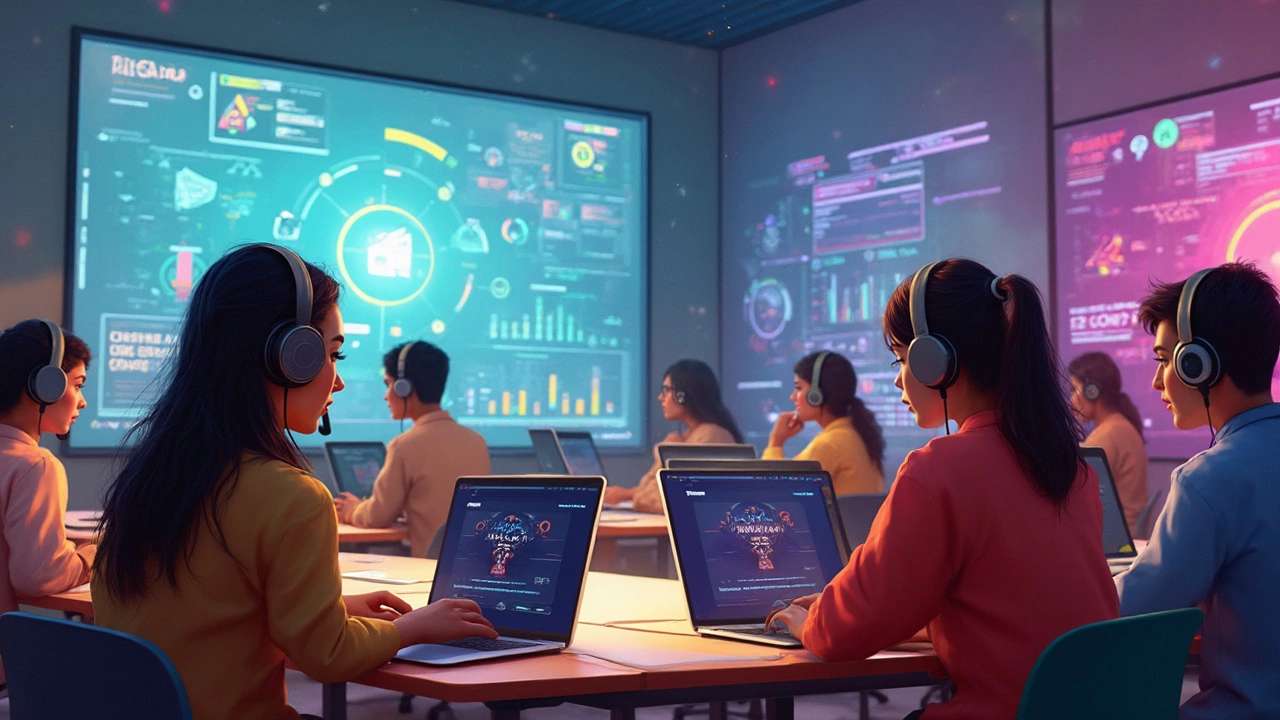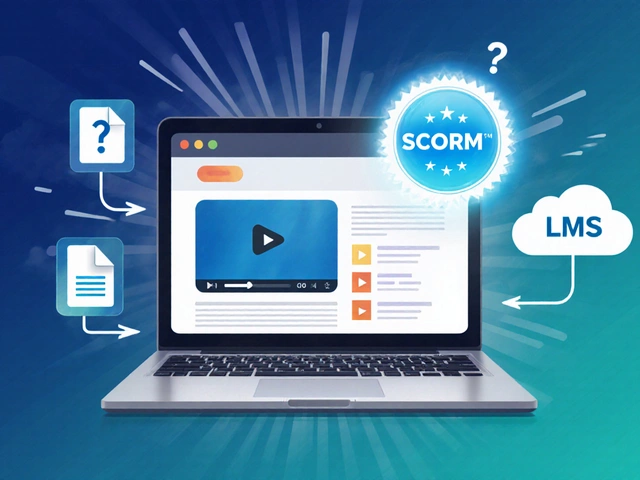
Ever wondered how the digital classroom really works its magic? Well, turns out eLearning isn't just about fancy tech or flashy apps. It's built on three crucial pillars called the Three P's: Personalization, Participation, and Progress Tracking. These aren't just buzzwords; they're the backbone of any successful online course.
Think about it. Personalization makes learning feel like it was designed just for you. Gone are the days of one-size-fits-all education. Whether you're brushing up on calculus or diving into art history, eLearning platforms can tailor content to fit your pace and interests. It's like having a lesson plan that knows what you need even before you do.
- Introduction to the Three P's
- Personalization in eLearning
- Encouraging Participation
- Importance of Progress Tracking
- Real-world Applications
- Future of eLearning
Introduction to the Three P's
In the bustling world of eLearning, it's easy to get lost in a sea of technology and content. But behind every successful eLearning platform lies a simple yet powerful framework known as the Three P's: Personalization, Participation, and Progress Tracking. These elements are not just catchy terms, but essential components that make online education effective and engaging.
The first 'P'—Personalization—is all about tailoring the educational experience to fit the unique needs of each learner. This isn't just a nice touch; it's a game-changer. By customizing courses to match individual learning styles and paces, online education becomes more accessible and enjoyable. Imagine being able to dive deeper into topics you love or move past subjects you already know; personalization makes this possible, helping learners stay motivated and invested.
Next comes Participation. Unlike traditional classrooms where passive listening might suffice, eLearning thrives on active engagement. Whether it's through discussion forums, interactive quizzes, or group projects, participation turns learners into active contributors rather than mere recipients of information. This interactive element not only enriches the learning experience but also fosters a sense of community among peers, making the learning process collaborative and inclusive.
The final 'P', Progress Tracking, acts as the compass in this learning journey. Imagine trying to improve without knowing where you stand—that's where progress tracking steps in. It provides learners with a clear view of their achievements and areas for improvement. Educators can also utilize this data to offer timely feedback, ensuring students stay on track and don't fall behind. Progress tracking is key to making learning outcomes transparent and achievable.
By integrating these three pillars, eLearning platforms can transform the virtual classroom into a dynamic space where learners feel supported and driven to succeed. And as education continues to evolve, the importance of the Three P's will only grow, ensuring that online learning remains both effective and learner-centered.
Personalization in eLearning
Alright, so personalization in eLearning is pretty much like having a tailor make you a custom suit but for education. It's all about making the learning experience fit you just right. But how does this magic happen? Well, it’s about using tech and data to adapt content to what you need and how you learn best.
Here’s the deal: not everyone learns the same way or at the same speed. Some folks might be visual learners, while others get more from listening or doing things hands-on. eLearning platforms are getting smart about this by using algorithms to track your progress and preferences. They then tweak the learning material to match your unique style. It’s like having a personal tutor who knows exactly where you might trip up and preps you beforehand.
One cool thing happening now is adaptive learning technology. This nifty feature adjusts in real-time as you go through the course content. Say you're breezing through one topic, the system might skip a bit of the extra info, speeding up your pace. But if you're struggling with another section, it might slow down and offer additional resources or quizzes to help you nail it.
Also, ever wondered why your app quizzes sometimes repeat similar types of questions? That's not a glitch. It's deliberate. Online education tools often implement spaced repetition—a technique where content or practice is repeated over increasing intervals. It's like giving your brain repeated nudges right when it might be about to forget something.
And since personalization is more than just academic content, there’s often a social angle, too. You might find yourself being grouped with peers who share your interests or learning challenges. This encourages collaboration and discussions that are much more meaningful than a general chat room.
Here's a quick snapshot of how personalization shakes things up:
- Adapts to learning speed and preferences
- Uses data to predict and remedy potential problem areas
- Incorporates spaced repetition for better memory retention
- Facilitates peer group collaboration based on shared learning paths
So, the next time you log into your favorite eLearning platform, take a moment to appreciate the choreography happening behind the scenes. It’s this attention to personal details that transforms impersonal online courses into something that feels designed just for you.
Encouraging Participation
Let's be honest, staring at a screen for hours isn't always the most exciting way to learn. That's where encouraging participation in eLearning platforms comes in. It's like when you're at a party, and someone pulls you into a conversation. Suddenly, things get lively! Bringing that vibe to the digital classroom is crucial for keeping students engaged and invested in their education.
First up, interactive elements can be game-changers. Incorporating quizzes, polls, and discussion boards makes learning a two-way street. You're not just absorbing information but actively participating, asking questions, and exchanging ideas with peers. Imagine attending a virtual class where you can immediately test your understanding or voice your opinions.
Boosting participation can also happen through group projects and collaboration tools. When learners work together, it fosters a sense of community. They get a chance to exchange perspectives and problem-solve, enhancing their understanding of the subject. Platforms that allow for real-time collaboration, like shared documents or video breakout rooms, make this possible even when students are miles apart.
Feedback loops play a vital role too. Timely feedback from instructors can encourage students to stay active. Being recognized for participation, even with a simple 'good job' or constructive critique, can motivate learners to keep contributing.
Here’s a snapshot of how participation boosts engagement in eLearning:
| Method | Impact |
|---|---|
| Interactive Quizzes | Increases retention by 50% |
| Discussion Boards | Fosters deeper understanding |
| Group Projects | Enhances collaboration skills |
Creating an engaging and participative environment on eLearning platforms means using multiple tools and strategies. So next time you're setting up or participating in an online class, remember that a little interaction can go a long way in making learning stick!
Importance of Progress Tracking
Ever tried navigating without a map? Progress tracking in eLearning is like having a GPS for your educational journey. It helps learners see exactly where they are, how far they've come, and what lies ahead. This feature isn't just about checking boxes; it's about giving students control over their learning process.
Tracking progress keeps motivation high. When you see your progress bar inching closer to 100%, it gives you a little victory boost. Plus, it highlights areas you might need to circle back on, helping to prevent those 'uh-oh' moments when exams come around. Parents and teachers love it too because it provides clear insights into the learners' strengths and areas needing support.
From a practical standpoint, educators can use progress tracking to tailor their instruction based on student needs. Instead of shooting in the dark, they can provide targeted feedback, additional resources, or alter the course pace. On some platforms, this data even allows for the creation of personalized learning paths based on individual progress and performance.
Here's something cool: many eLearning platforms are incorporating analytics to crunch these progress numbers. For instance, completion rates, quiz scores, and participation levels can all be tracked, offering both students and instructors a clear roadmap of the learning journey.
In a nutshell, progress tracking is essential for both keeping students engaged and helping educators teach smarter, not harder. It's like having a personal coach cheering you on and giving tips just when you need them most.
Real-world Applications
Alright, how do these Three P's of eLearning actually play out in the real world? Let's dive into some scenarios where you can see these principles in action.
First off, take universities. Many have adopted online courses integrated with AI to handle personalization. Imagine being a computer science student where your learning path adjusts based on your progress. The system might suggest extra resources on algorithms if you're breezing through the basics but hitting a wall with advanced topics.
In the corporate world, eLearning platforms are changing how employee training happens. Companies like IBM use digital learning systems that adjust training modules based on employee feedback and performance. This participation ensures that learners are engaged, while tracking tools help managers identify stars and those needing more support.
Let's not forget K-12 education. Schools are increasingly using apps that incorporate gamification to boost participation and interest. Teachers can see real-time progress tracking and help out right when a student begins to struggle. Plus, parents often get updates on their child's progress, making it a team effort.
Even language learning platforms like Duolingo use these concepts. They customize lessons for users (personalization), encourage daily practice with interactive exercises (participation), and provide detailed progress reports.
If you're a numbers person, here's an interesting tidbit: According to a 2024 survey by the eLearning Industry, over 58% of students who experienced personalized learning tools felt more motivated than those with traditional formats.
These examples show that the Three P's aren't just theory; they're actively reshaping education and training everywhere. It's an exciting time for online learners and educators alike.
Future of eLearning
The world of eLearning is evolving faster than a viral TikTok dance. With advancements in technology, the future is looking not just bright but downright dazzling. Artificial Intelligence is making waves by personalizing learning experiences to an entirely new level. Imagine AI that can predict what resources a student might need next—crazy, right?
Virtual and Augmented Reality (VR/AR) aren't far behind either. They're taking online education from two-dimensional screens to immersive 3D experiences. Picture a history class where you actually walk through ancient Rome or a biology class where you're standing in the middle of a cell. That's the futuristic classroom.
Blended learning, where traditional settings mix with digital platforms, is also becoming a go-to approach. It brings the best of both worlds, allowing students to enjoy the structured environment of a classroom while benefiting from the flexibility of online resources. This hybrid model is gaining popularity among schools and universities across the globe.
Let's talk numbers. A Survey by a reputable online education firm projected that by 2026, the global eLearning market is expected to reach an astounding $400 billion. That’s a lot of zeros and a clear sign that both individuals and institutions are placing their bets on digital education.
Even the workplace is getting on board. Companies are integrating eLearning into their training programs, giving employees the power to upskill at their own pace. It's no surprise remote and hybrid work models are making it a necessity rather than a luxury.
| Year | Projected eLearning Market Size (Billions USD) |
|---|---|
| 2022 | 200 |
| 2024 | 300 |
| 2026 | 400 |
So, what's the takeaway? eLearning isn’t just a temporary shift; it’s a revolution in how we perceive and consume education. With endless possibilities in tech and accessibility, the future promises not just learning but learning reimagined.







